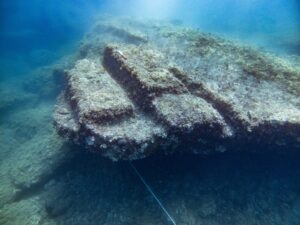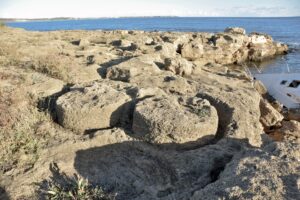Along the entire coastline of southern Crotoniatide, characterized by majestic headlands and picturesque inlets, numerous ancient quarries of sandstone and calcarenite have been identified, some of which are well preserved. These quarries are found both in shallow waters near the coast and on rocky outcrops in the immediate hinterland (Fig. 1).

In antiquity, these quarries were exploited to extract high-quality stone material, highly valued for its architectural significance, to supply Crotone—especially during its period of greatest power, following the victory over its rival Sybaris (510 BC), when the polis dominated much of the present-day Calabrian peninsula. The temple of Hera on the Lacinian promontory and the Hellenistic fortification of Le Castella were built using this material. The constant movement of boats ferrying column drums, cornices, architraves, and squared blocks between the quarries and the city enabled the Crotoniates to construct their long and imposing defensive walls, as well as the monumental civic and religious buildings that have been partially uncovered through archaeological excavations.
Evidence of quarrying activity has been found at Le Castella, about 50-60 meters west of the keep, in a stretch of sea characterized by a broad rocky platform at depths ranging from 3 to 9 meters. This quarry, covering an area of approximately 300 square meters, features a peculiar staircase carved directly into the rock and numerous extraction cuts for parallelepiped-shaped blocks, giving the seabed its distinctive stepped appearance. Some of these blocks were quarried and left in place; others, which were intended for extraction, were outlined by cuts and incisions (Fig. 2). The dimensions and shapes of both the extracted and partially quarried blocks closely match those used in the Hellenistic fortress located on the islet. Additionally, numerous squared extraction cuts can be seen near the submerged quarry on the Punta Cannone cliff, just east of the fortress of Le Castella.

The extraction of calcarenite during the Greek period is also definitively documented near the dock of Le Castella’s tourist port, where a large quarry has been identified. This site primarily provided column drums (Fig. 3). Just north of the small harbor, the extensive rocky outcrop still preserves several partially quarried column drums and a dense network of circular cuts whose diameters match those of the drums forming the shaft of the sole surviving column of the temple of Hera Lacinia at Capo Colonna. In this quarry, squared block cuts, small-sized column drums, and a few unquarried drums identical to those found in the so-called “Building B” of the Lacinian Heraion can also be observed.

Credits
Artomed-Lab, Dipartimento di Culture, Educazione e Società – Università della Calabria